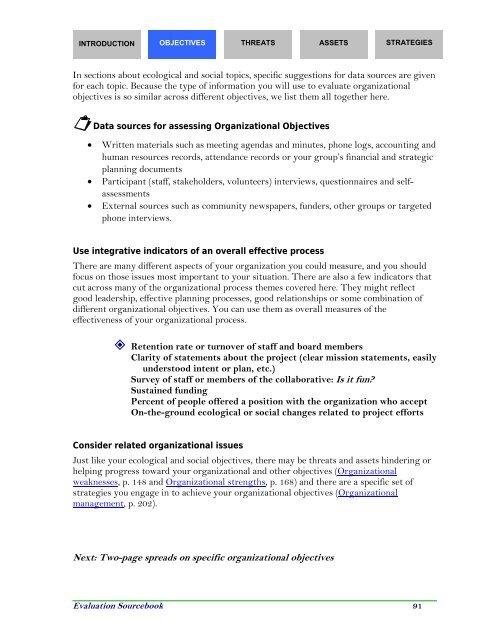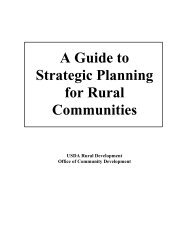Evaluation Sourcebook (.pdf) - School of Natural Resources and ...
Evaluation Sourcebook (.pdf) - School of Natural Resources and ...
Evaluation Sourcebook (.pdf) - School of Natural Resources and ...
- No tags were found...
Create successful ePaper yourself
Turn your PDF publications into a flip-book with our unique Google optimized e-Paper software.
INTRODUCTION OBJECTIVES THREATS ASSETS STRATEGIESIn sections about ecological <strong>and</strong> social topics, specific suggestions for data sources are givenfor each topic. Because the type <strong>of</strong> information you will use to evaluate organizationalobjectives is so similar across different objectives, we list them all together here.Data sources for assessing Organizational Objectives• Written materials such as meeting agendas <strong>and</strong> minutes, phone logs, accounting <strong>and</strong>human resources records, attendance records or your group’s financial <strong>and</strong> strategicplanning documents• Participant (staff, stakeholders, volunteers) interviews, questionnaires <strong>and</strong> selfassessments• External sources such as community newspapers, funders, other groups or targetedphone interviews.Use integrative indicators <strong>of</strong> an overall effective processThere are many different aspects <strong>of</strong> your organization you could measure, <strong>and</strong> you shouldfocus on those issues most important to your situation. There are also a few indicators thatcut across many <strong>of</strong> the organizational process themes covered here. They might reflectgood leadership, effective planning processes, good relationships or some combination <strong>of</strong>different organizational objectives. You can use them as overall measures <strong>of</strong> theeffectiveness <strong>of</strong> your organizational process. Retention rate or turnover <strong>of</strong> staff <strong>and</strong> board membersClarity <strong>of</strong> statements about the project (clear mission statements, easilyunderstood intent or plan, etc.)Survey <strong>of</strong> staff or members <strong>of</strong> the collaborative: Is it fun?Sustained fundingPercent <strong>of</strong> people <strong>of</strong>fered a position with the organization who acceptOn-the-ground ecological or social changes related to project effortsConsider related organizational issuesJust like your ecological <strong>and</strong> social objectives, there may be threats <strong>and</strong> assets hindering orhelping progress toward your organizational <strong>and</strong> other objectives (Organizationalweaknesses, p. 148 <strong>and</strong> Organizational strengths, p. 168) <strong>and</strong> there are a specific set <strong>of</strong>strategies you engage in to achieve your organizational objectives (Organizationalmanagement, p. 202).Next: Two-page spreads on specific organizational objectives<strong>Evaluation</strong> <strong>Sourcebook</strong> 91






